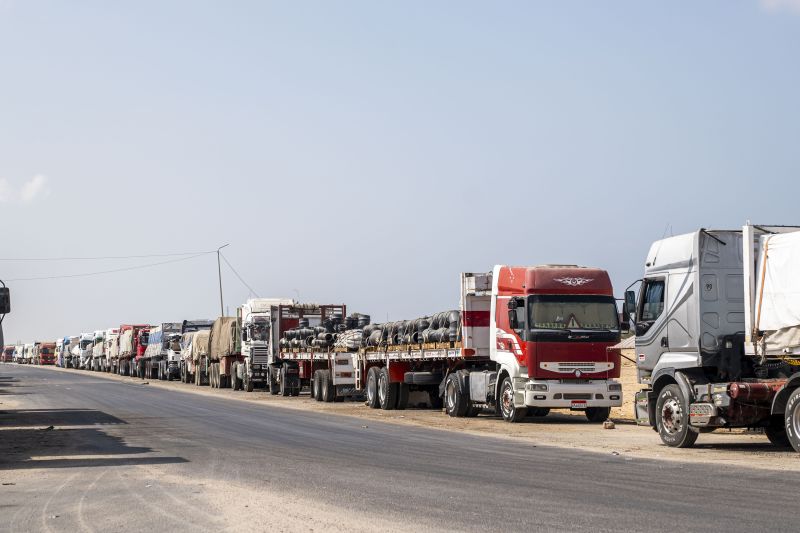A US deadline for Israel to improve getting humanitarian aid into Gaza has expired, with the Biden administration assessing that Israel is not blocking aid and so is not violating US law governing foreign military assistance.
The State Department said that while changes were needed, progress had been made – so there would be no disruption to US arms supplies.
But the US view is a stark contrast with the bleak picture on the ground, where much of the aid that reaches Gaza is not being distributed.
Civilians fleeing northern Gaza after weeks of intense Israeli military operations tell of a chronic lack of food and people dying of hunger, as aid agencies warn that the area is on the brink of famine.
The accounts of desperate civilians echo the the World Health Organization’s warning last Friday of “a strong likelihood that famine is imminent in areas within the northern Gaza Strip.”
Multiple factors have contributed to what aid agencies are calling the worst point for the humanitarian situation in Gaza since the war began in October 2023.
They include ongoing Israeli military operations, evacuation orders affecting hundreds of thousands of people, a breakdown in law and order that has led to looting of aid convoys, a lack of truck drivers and the frequent denial of passage for aid by Israeli authorities.
Last month, the Biden administration gave Israel a 30-day deadline to take specific steps to improve the humanitarian situation in Gaza, including boosting commercial traffic and ending the isolation of the north.
As the deadline expired, the US State Department said it had “not made an assessment that the Israelis are in violation of US law” and that they would face no penalties.
Much of the aid community disagrees.
On Tuesday, eight humanitarian organizations said the Israeli government “not only failed to meet the U.S. criteria that would indicate support to the humanitarian response, but concurrently took actions that dramatically worsened the situation on the ground, particularly in northern Gaza.”
“We really are at a tipping point in terms of this turning into a catastrophic food insecurity situation,” Phillips-Barrasso said.
According to the World Food Programme, the average number of trucks entering Gaza fell to just 58 per day in the second half of October, the lowest level since November last year.
Before the war began, around 500 commercial and aid trucks were entering each day.
COGAT, the Israeli agency that approves aid shipments into Gaza, said Saturday that 713 aid trucks had arrived in northern Gaza through the Erez West crossing since the beginning of October. But much of this aid remains at the crossing point.
Aid organizations have often said that distribution of food and water amid Israeli strikes, evacuation orders and the absence of secure corridors is almost impossible.
Last week, it said, an approved convoy of ten food trucks was held for two hours in Jabalya, “where some of the food was offloaded by people who surrounded the trucks.”
The food never reached locations where displaced Palestinians were sheltering, it said.
Joyce Msuya, acting UN under-secretary-general for humanitarian affairs, told the UN Security Council Tuesday that Israeli authorities were “blocking humanitarian assistance from entering North Gaza, where fighting continues, and around 75,000 people remain with dwindling water and food supplies.”
A planned 14-truck WFP aid convoy had intended to deliver supplies to Beit Hanoun and the Indonesian Hospital in Jabalya, but only two trucks reached their destination due to “delays in movement authorization and crowded routes,” OCHA said on Tuesday.
The Israeli military said Tuesday that “hundreds of food packages and thousands of liters of water were delivered to distribution centers for the civilian population remaining in the Beit Hanoun area” on Monday.
But shipments of such size only scratch the surface of the immense need.
In addition to the lack of aid, 13 months of constant air strikes have left agriculture and industry in Gaza in ruins. Most of the enclave’s agricultural land is in the north and along the eastern border with Israel, areas from which hundreds of thousands of people have fled.
The vast majority of Gazans have little or no work and can’t afford to buy food at inflated prices.
Communal soup kitchens and bakeries are also closing or short of supplies.
There is also the issue of profiteering. On Sunday, dozens of people marched through a market in Khan Younis in southern Gaza, chanting: “We are the people, you merchants are thieves!”
But much of the looting is by organized gangs.
The president of Gaza’s Transportation Association, Nahd Shuheiber, said this week there has been “an increase in the theft of trucks loaded with humanitarian aid,” because of a lack of police.
Police in Gaza have often been targeted by Israeli strikes as they are seen as being associated with Hamas.
Shuheiber said that “bandits” near the Kerem Shalom crossing had been stealing from the trucks, “creating a state of chaos under which we are unable to operate effectively.”
“And as a result, we are likely to have people starving to death literally miles away from where food is available.”
Khader Al-Za’anoun of Wafa, the official Palestinian news agency, contributed reporting.

